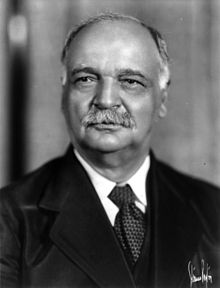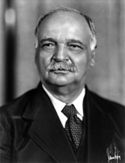Charles Curtis
Charles Curtis (* 25. Januar 1860 in Topeka, Kansas; † 8. Februar 1936 in Washington, D.C.) war ein US-amerikanischer Politiker der Republikanischen Partei und von 1929 bis 1933 der 31. Vizepräsident der Vereinigten Staaten.
Seine Mutter entstammte dem Volk der Kansa. Charles Curtis war der erste – und der bisher einzige – indianischstämmige Politiker, dem es gelang, derart hohe politische Ämter einzunehmen.
Curtis studierte die Rechtswissenschaften und war als Anwalt in Topeka tätig. Von 1885 bis 1889 war er Staatsanwalt im Shawnee County. Von 1893 bis 1907 gehörte er als Abgeordneter dem US-Repräsentantenhaus an. Am 23. Januar 1907 wurde er als Nachfolger des zurückgetretenen Joseph R. Burton zum US-Senator gewählt – als erster indianisch-stämmiger Politiker. Zeitweise bekleidete er im Senat auch das Amt des Präsidenten pro tempore. Nach einer gescheiterten Wiederwahl schied er 1913 zunächst aus dem Amt, wurde aber 1915 erneut Senator und wurde 1920 und 1926 erfolgreich wiedergewählt.
Bei der Präsidentschaftswahl 1928 errang er als Running Mate an der Seite von Herbert Hoover einen hohen Sieg gegen die Demokraten Al Smith und Joseph Taylor Robinson, woraufhin er 1929 vom Senat in das Amt des Vizepräsidenten wechselte. Die Niederlage bei der Präsidentschaftswahl 1932 beendete auch die politische Karriere von Curtis, der am 8. Februar 1936 im Alter von 76 Jahren nach einem Herzinfarkt starb.
Im Jahre 1932 eröffnete Curtis die Olympischen Sommerspiele von Los Angeles.
Charles Curtis war der Autor des Curtis Act von 1898, welcher den Indianerstämmen im Indianerterritorium 90 Millionen Acre nahm und die Stammesregierungen ihre Autonomie kostete. Der Curtis Act ermöglichte die Besiedlung von Oklahoma durch Nicht-Stammesmitglieder. Charles Curtis glaubte an individuellen Landbesitz und war ein Gegner von Land im Besitz der Stämme. Er glaubte, dass nur eine Anpassung der Stämme an die westlichen Ideale den Fortbestand der Indianer garantieren könne. Stammesregierungen waren in seinen Augen hinderlich für den Fortschritt der Indianer. Das Gesetz führte zur Auflösung der Cherokee Nation.[1][2] Charles Curtis selbst war aber unglücklich über das Gesetz, da es durch mehrere Revisionen ging und mit seinem ursprünglichen Entwurf wenig gemeinsam hatte.[3][4]
Literatur
- Jules Witcover: The American Vice Presidency: From Irrelevance to Power. Smithsonian Books, Washington, D. C. 2014, ISBN 978-1-58834-471-7, S. 290–297 (= 31. Charles Curtis of Kansas).
Weblinks
- Charles Curtis im Biographical Directory of the United States Congress (englisch)
- Curtis, Charles – Eine Biographie (englisch)
- Charles Curtis in der Datenbank von Find a Grave (englisch)
- Zeitungsartikel über Charles Curtis in den Historischen Pressearchiven der ZBW
- Charles Curtis im Miller Center of Public Affairs der University of Virginia (englisch)
Einzelnachweise
- ↑ Oklahoma Historical Society CURTIS ACT (1898).
- ↑ Native Heritage Project The Curtis Act of 1898: The Curtis Act called for the abolition of tribal governments on March 6, 1906. It was intended to establish the concept of individual land holdings.
- ↑ Native Heritage Project The Curtis Act of 1898: He believed that the Five Civilized Tribes needed to make changes. He thought that the way ahead for Native Americans was through education and use of both their and the majority cultures, but he also had hoped to give more support to Native American transitions.
- ↑ uslegal Curtis Act Law and Legal Definition
| Personendaten | |
|---|---|
| NAME | Curtis, Charles |
| KURZBESCHREIBUNG | US-amerikanischer Politiker |
| GEBURTSDATUM | 25. Januar 1860 |
| GEBURTSORT | Topeka, Kansas |
| STERBEDATUM | 8. Februar 1936 |
| STERBEORT | Washington, D.C. |
Auf dieser Seite verwendete Medien
Seal of the Vice President of the United States. The blazon is defined in Executive Order 11884 as:
The design is the same as the Seal of the President of the United States, except that there is no ring of stars, the clouds are gray (instead of proper), the stars are gray (instead of argent), the scroll is gray (instead of white), the arrows are gray (instead of proper), and the background colors and inscription (obviously) differ.The Coat of Arms of the Vice President of the United States shall be of the following design:
SHIELD: Paleways of thirteen pieces argent and gules, a chief azure; upon the breast of an American eagle displayed holding in his dexter talon an olive branch proper and in his sinister a bundle of thirteen arrows gray, and in his beak a gray scroll inscribed "E PLURIBUS UNUM" sable.
CREST: Behind and above the eagle a radiating glory or, on which appears an arc of thirteen cloud puffs gray, and a constellation of thirteen mullets gray.
The Seal of the Vice President of the United States shall consist of the Coat of Arms encircled by the words "Vice President of the United States."
Unofficial seal of the United States House of Representatives, based directly on the Great Seal of the United States. The official seal depicts the House side of the Capitol building,[1] but this is still a commonly seen symbol.
Autor/Urheber:
Louis Dreka designed the actual seal, first used in 1885 per here. Vectorized from a version in stained glass.
The Seal of the United States Senate, the upper house of the United States Congress. See also the Seal of the United States House of Representatives.
Charles Curtis.
Signature of Charles Curtis.
Seal of the President Pro Tempore of the United States Senate, vectorized in Inkscape










